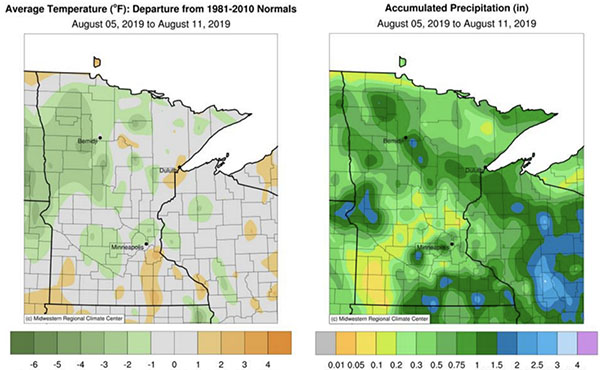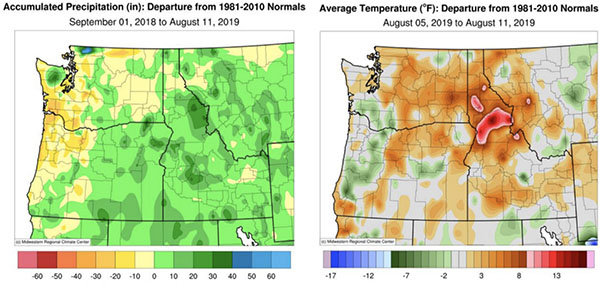August 15, 2019
For the week ending August 11th, the dry pea harvest continued to advance, and the lentil harvest got underway.

Following a planting season marked by rain delays, the crop is starting to make up lost ground as warm summer weather is reported in the major pulse growing areas.
Michigan is an important black bean growing state. There were 6.1 days suitable for fieldwork last week. Throughout most of the state, temperatures were warm and there was little precipitation. Dry bean crop development remains behind schedule, with 66% of the plants blooming and 24% setting pods. That compares with the five-year average of 86% and 54%, respectively. The crop rated 5% very poor, 15% poor, 23% fair, 40% good and 17% excellent.
Minnesota is a key kidney bean growing state. Last week, there were 5.7 days suitable for fieldwork. Topsoil moisture rated 88% adequate to surplus. Subsoil moisture rated 91% adequate to surplus. The dry bean crop is nearly on schedule and progressing nicely, with 96% of the plants blooming and 83% setting pods. The crop rated 7% very poor to poor, 33% fair, 54% good and 6% excellent.

Montana is a major producer of pulse crops. Conditions were similar to last week, with warm and humid weather across the state. Top- and subsoil moisture rated 74% and 70% adequate to surplus. This week, the chickpea harvest got underway. As of August 11th, 1% of the crop had been harvested, behind the average pace of 29% for this date. The dry pea and lentil harvests, meanwhile, advanced to 35% and 9%, respectively. Both are also behind the normal pace, which is 68% for peas and 54% for lentils. In terms of crop ratings, the dry pea crop rated 5% very poor to poor, 30% fair, 52% good and 13% excellent. The lentil crop rated 4% poor, 37% fair, 46% good and 13% excellent.
North Dakota is the country’s top dry bean producing state. There were 5.9 days suitable for fieldwork last week. Topsoil moisture rated 75% adequate to surplus. Subsoil moisture rated 70% adequate to surplus. Dry pea crop harvest is at 23%. The crop rated 3% poor, 21% fair, 69% good and 7% excellent, with 91% of the plants dropping leaves, ahead of the average of 80%. The dry bean crop continued to develop, with 96% of the plants blooming, 78% setting pods and 3% dropping leaves. Last week saw the start of the lentil harvest, with 1% of the crop combined.
The Pacific Northwest is an important pulse producing region. Last week, there were reports of hail in Oregon and Washington, and storms in Idaho. Even so, farmers were able to make good progress, with 6.6 days suitable for fieldwork in Idaho, 6.4 in Oregon and 6.3 in Washington. The region’s dry pea harvest continued to advance, with harvest progress at 19% in Idaho, 77% in Oregon and 69% in Washington. In Idaho, the crop rated 42% fair, 52% good and 6% excellent. Turning to dry beans, Idaho’s crop rated 34% fair, 63% good and 3% in excellent. In Oregon, it rated 8% very poor to poor, 28% fair, 52% good and 12% excellent. In Washington, it rated 48% fair and 52% good.

Disclaimer: The opinions or views expressed in this publication are those of the authors or quoted persons. They do not purport to reflect the opinions or views of the Global Pulse Confederation or its members.